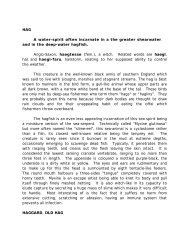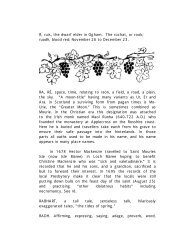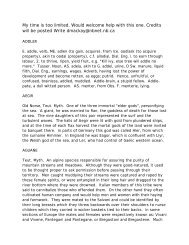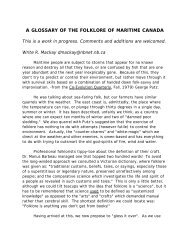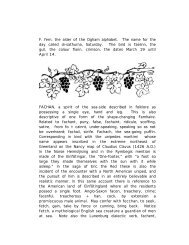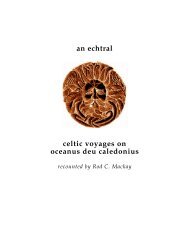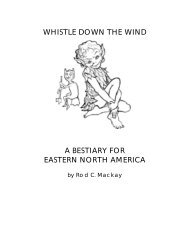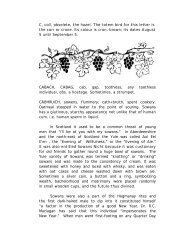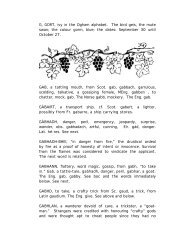L, luis, the mountain ash in the Ogham. Confers ... - Rodney Mackay
L, luis, the mountain ash in the Ogham. Confers ... - Rodney Mackay
L, luis, the mountain ash in the Ogham. Confers ... - Rodney Mackay
You also want an ePaper? Increase the reach of your titles
YUMPU automatically turns print PDFs into web optimized ePapers that Google loves.
to have a bronze roof. With<strong>in</strong> <strong>the</strong>y found <strong>the</strong> rider to be <strong>the</strong><br />
k<strong>in</strong>g of that place, “and <strong>the</strong>re was never seen a man like him<br />
<strong>in</strong> Teamhair for comel<strong>in</strong>ess or for beauty, or for <strong>the</strong> wonder<br />
of his face.” This k<strong>in</strong>g identified himself as Lugh of <strong>the</strong><br />
Long Arm, and foretold that Conn would live through a<br />
hundred battles and named <strong>the</strong> k<strong>in</strong>gs of his l<strong>in</strong>eage. The<br />
party afterwards toasted Art mac Conn, who was not yet<br />
born, and when Conn was returned to his own plane he found<br />
himself still <strong>in</strong> possession of <strong>the</strong> outland dr<strong>in</strong>k<strong>in</strong>g vessel.<br />
LIAGÁN, “born of stone,” <strong>the</strong> stand<strong>in</strong>g stone, <strong>the</strong> simplest<br />
type of monument known to archaeology.The word is also<br />
represented as gallán or dallán. Elsewhere <strong>in</strong> Europe <strong>the</strong><br />
stand<strong>in</strong>g-stone is known as a monolith or menhir. Some of<br />
<strong>the</strong>se are grave markers, o<strong>the</strong>rs boundary stones and some<br />
“stones <strong>in</strong>vested with a sacred character.” These latter are<br />
<strong>the</strong> fear bréagach, <strong>the</strong> “powerful men.” See cromleac, i.e.<br />
“Crom’s stand<strong>in</strong>g-stone.”<br />
LIAGÁN TRIONAD, any group<strong>in</strong>g of three monoliths, often<br />
found support<strong>in</strong>g a cap-stone; <strong>the</strong> so-called tripod or table<br />
dolmens. Examples may be seen at Legananny, County Down<br />
and at Haroldstown, County, Carlow, Ireland. In North<br />
America <strong>the</strong>se liagánean are referred to as pedestal rocks.<br />
At least two examples of <strong>the</strong>se peculiar structures<br />
have been unear<strong>the</strong>d <strong>in</strong> Nova Scotia accord<strong>in</strong>g to a short<br />
article published <strong>in</strong> magaz<strong>in</strong>e called “The Forest Times.”<br />
They were said to consist of cover<strong>in</strong>g stones each<br />
“weigh<strong>in</strong>g about 25 tons and mounted on three legs.” The<br />
“Times” wanted Prov<strong>in</strong>cial Foresters to report f<strong>in</strong>d<strong>in</strong>g any<br />
o<strong>the</strong>r specimens of this type. If <strong>the</strong> “legs” are mere<br />
boulders <strong>the</strong>n <strong>the</strong> North American structures may be counted<br />
as accidental glacial debris, but if <strong>the</strong>y are true pillars, as<br />
<strong>the</strong> name suggests, <strong>the</strong>y are likely man-made. We have seen<br />
it suggested that <strong>the</strong> stones were put <strong>in</strong> place “before <strong>the</strong><br />
English and <strong>the</strong> French began to contest N.S.,” and noted<br />
that <strong>the</strong>y could have been primitive stamp<strong>in</strong>g mills to<br />
separate gold from rock debris. That is a somewhat remote



